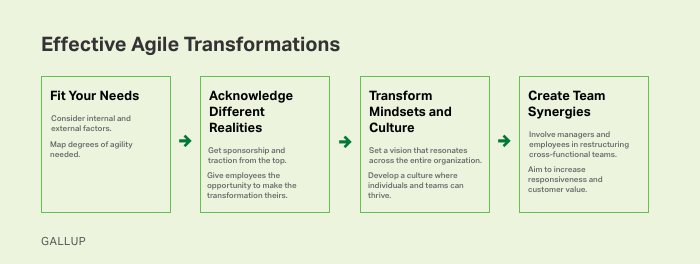Story Highlights
- True agile transformation is individualized and multidimensional
- The transformation must involve employees at every level
- Clearly define the "why" of transformation and focus on culture
Customer needs are changing faster and more unpredictably than ever before. Keeping up with the dizzying, accelerated pace of their demands requires true agile transformation. This kind of change goes much deeper than simply adopting a widely used organizational framework like Kanban or Scrum. It means fully committing to making individualized, well-thought-out, multidimensional changes to a company's DNA.
So, where do you start?
Defining Agility for Your Organization
To really pull this off, the best leaders start with asking some provocative questions:
- What does "agility" really mean to our company?
- Exactly how will this change the way we work?
- In what specific ways will we -- and especially our customers -- be better off?
- What degree of agility do we need in various, specific areas of our business?
What's become clear is that most leaders aren't asking these questions -- or at least aren't coming up with good answers.
Despite all the chatter and the flurry of urgent activity around agility, Gallup research discovered that less than one-fifth of the employees in Spain, France, Germany and the UK consider their companies to be fully agile.
Implementing an agile transformation in an incomplete or ineffective way is actually worse than doing nothing at all.
This is a huge problem. Implementing an agile transformation in an incomplete or ineffective way is actually worse than doing nothing at all. It can have disastrous consequences, like systemic complexity leading to confusion. Depressed engagement leading to declining performance. Higher turnover. Falling profit. This list goes on …
There's too much on the line to get it wrong. So, get it right by following these critical recommendations for effective agile transformations.

For agile transformations to be efficient and drive performance, they must:
1. Fit Your Needs
Not all companies and departments will need agile, but every single one of them needs to react faster to emerging trends and customer needs. Internal factors (such as scaling capabilities) and external factors (such as regulatory complexity) help determine the extent to which structures and processes can be changed. Mature agility is tailored to your organization.
Once these internal and external factors are assessed, organizations need to map the degrees of agility they'll need to adopt for the organization to thrive.
2. Acknowledge the Different Realities
To make the most of agile transformations, leaders need to be held accountable and sponsor the transition. That said, involving lower levels is equally important. The benefits are clear: it helps avoid blind spots when defining strategies by providing a more realistic picture of the role agile plays both in driving change and identifying current best practices that can be exported to propel agile to the rest of the organization.
It also gives employees the opportunity to make the transformation theirs, which generates traction. Just as agile organizations involve customers in product development, agile transformations involve employees in the transformation process. As a result, agile coaches need to partner with line managers to align initiatives with the different needs across departments.
Just as agile organizations involve customers in product development, agile transformations involve employees in the transformation process.
In the scope of the transformation, simplifying the way product development and client teams work is a must.
But for more heavily regulated functions that are less prone to disruption, agile benefits are more limited -- and initiatives and strategies can shift appropriately.
3. Transform Mindsets and Culture
Once organizations decide which structures and processes will be transformed using agile principles, they can determine the extent and urgency of the transformation. This sets a distinct northern star for the entire organization -- a clear vision that's evident to all areas, seniority levels and job functions.
When this vision is shared through effective communication in all levels of the organization, companies can develop a solid workplace culture where individuals and teams can thrive. Agile is all about quick iterations and variability, but solid, foundational principles must be rigorously implemented to provide clarity and sustain an engaged workforce.
The global pharmaceutical company Roche has undergone a companywide transformation during the last few years. As Tammy Lowry, Global Head of Talent Innovation, pointed out in a CHRO interview, everything starts with setting a company culture that fosters an agile mindset.
"When you talk about an agile mindset and an agile organization, it has nothing to do with sprints or all that other kind of stuff. From a technical perspective, it's more about clear platforms that give you simplicity around those things that need to happen regularly, fluidity in roles to enable flexible resource utilization, simplicity in governance processes, etc."
4. Create Team Synergies
Talented, collaborative, cross-functional teams are the foundation of agile transformations. To translate an agile culture into actions, building the right structures to support teams is crucial.
Leaders need to involve functional managers and employees in the process of reshaping these cross-functional teams. The ultimate goal will always be to create efficiencies that help teams be responsive and add value.
Avoid Agility Pitfalls With an Individualized 'Why'
Agile transformations are challenging. They affect an organization's people, processes and structures. Common pitfalls include starting too big, not having enough resources to scale up beyond pilot projects or failing to account realistically for the impacts it will have at the functional level.
To avoid these and other dangers, leaders must start by understanding the individualized "why" of agile transformation. Then they need to work together to establish and communicate a vision that reflects and addresses the authentic realities of what people and teams need to get their work done faster, more responsively, and with greater excellence.
Start your transformation:
- Assess your current culture and create your vision for the future.
- Design an employee experience that increases agility.





